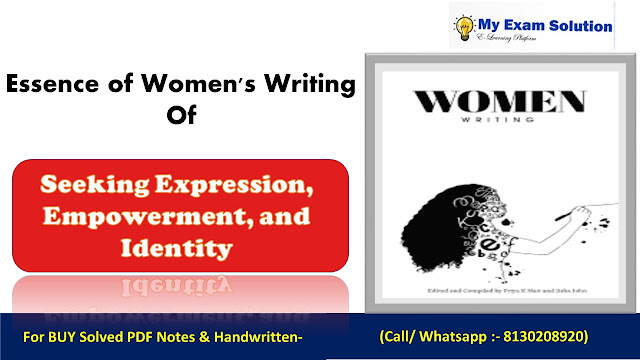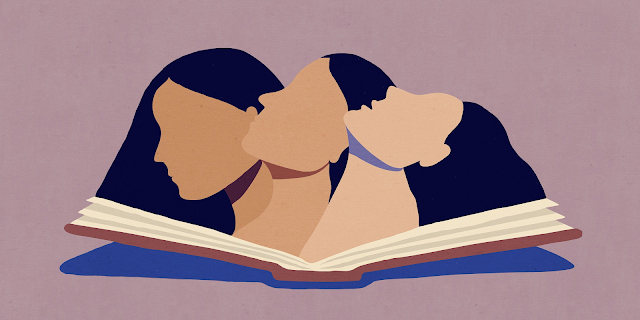Exploring the Essence of Women's Writing Seeking Expression, Empowerment, and Identity
Women's writing is a multifaceted
and rich tapestry encompassing many genres, cultures, and eras. It is an
effective way for women to communicate their ideas, feelings, and experiences.
Women's writing is unique because it can convey a distinct viewpoint on life,
frequently addressing issues that are unique to women or offering a novel
interpretation of themes that are universal.
Self-Expression and Empowerment:
Exploring the Essence of Women's Writing Seeking Expression, Empowerment, and Identity-Women writers write primarily for
the purpose of self-expression. Women have historically experienced social
restrictions that have restricted their voices and viewpoints. Women use
writing as a platform to reclaim their narratives and as a way to express their
ideas, emotions, and experiences. Through writing, women writers challenge the
traditional roles that have been assigned to them and assert their agency. In
addition to being a therapeutic process, this kind of self-expression empowers
women by allowing them to claim their uniqueness and escape the confines of
social norms.
Exploring the Essence of Women's Writing Seeking Expression, Empowerment, and Identity-One common theme in women writers'
works is the investigation of female identity. Writers frequently explore the
complexities of womanhood, discussing the subtleties of forming an identity
within the framework of cultural, social, and individual dimensions. Women
writers use their stories to question and reinterpret social norms and the
roles that are imposed upon them. Reclaiming one's identity is a celebration of
the rich and varied experiences of women, not merely a sign of disobedience.
Social Commentary and Advocacy:
For many years, women's writing has
been a powerful medium for social criticism and advocacy. Many female writers
use their writing to highlight the injustices, inequalities, and difficulties
that women encounter in society. A close attention to detail and a profound
comprehension of the real-life experiences of women are used to examine themes
like violence against women, reproductive rights, and gender discrimination.
Women writers hope to inspire change, challenge social norms, and elicit
thought through their storytelling.
BUY PDF & Book
WhatsApp - 8130208920
Exploring the Essence of Women's Writing Seeking Expression, Empowerment, and Identity-The feminist movement has been
closely intertwined with women's writing, with authors contributing
significantly to the discourse on gender equality. From the early works of Mary
Wollstonecraft to contemporary voices like Chimamanda Ngozi Adichie, women
authors have played a pivotal role in articulating the demands for equal rights
and opportunities. Their writings serve as a call to action, encouraging
readers to question and challenge ingrained patriarchal structures.
Intimacy and Emotional Landscapes:
The personal and emotional spheres
of women's lives are frequently explored in women writers. The examination of
love, loss, family dynamics, and relationships offers a complex picture of the
emotional depth of women's experiences. Women writers develop sympathetic
relationships with readers by sharing their stories, which helps readers gain a
better understanding of the difficult emotional paths that women take.
Memoirs and autobiographies by
women writers offer a glimpse into their personal struggles, triumphs, and
transformations. This transparency not only serves as a form of self-therapy
but also resonates with readers who may find solace and inspiration in shared
experiences. The emotional authenticity in women's writing acts as a bridge,
connecting diverse individuals through the common thread of human emotion.
Breaking Stereotypes and Challenging
Narratives:
Women's writing actively challenges
stereotypes and redefines traditional narratives. By presenting
multidimensional female characters and subverting established tropes, women
authors contribute to the reshaping of cultural perceptions. The portrayal of strong,
independent women who defy societal expectations becomes a means of inspiring
readers and dismantling ingrained stereotypes.
Also Read-
- Can The Yellow Wallpaper Be Described As Self-Confessional Literature
- How Does Ambai Critique Patriarchy In Her Story
- What Are The Issues That Mary Wollstonecraft Touches Upon
Through the creation of diverse
narratives, women writers showcase the breadth and depth of women's
experiences. They challenge the notion of a singular, universal female
experience and, instead, highlight the richness of individual stories shaped by
various factors such as race, class, and sexual orientation. This diversity in
representation not only offers a more accurate reflection of reality but also
fosters inclusivity within the literary landscape.
Conclusion
Women's writing is a rich tapestry of themes including empowerment, self-expression, social commentary, emotional exploration, and stereotype subversion. Across time and cultures, women writers have used the power of storytelling to take back control of their stories, question accepted wisdom, and spur social change.
Through their literary works,
women authentically portray the diverse and multifaceted nature of their
experiences, promoting reader connections and advancing a more inclusive
understanding of humanity. As we commemorate this essay's one-year anniversary,
we must recognize the continued development of women's writing and its enduring
influence on influencing cultural narratives and advancing a more just and
compassionate world.
IMPORTANT QUESTIONS
Q1: How has women's writing evolved over time?
A: Women's writing has evolved
significantly over time, reflecting changes in societal attitudes, cultural
shifts, and advancements in feminist thought. Earlier works often focused on
advocating for basic rights and challenging oppressive norms, while
contemporary women's writing explores a broader range of themes, delving into
intersectionality, diverse identities, and the complexities of modern
womanhood.
Q2: Can you provide examples of influential women authors and
their contributions?
A: Certainly! Mary Wollstonecraft,
with her groundbreaking work "A Vindication of the Rights of Woman,"
laid the foundation for feminist thought. Virginia Woolf's "Mrs.
Dalloway" and "Orlando" challenged narrative conventions. Audre
Lorde, through essays like "The Master's Tools Will Never Dismantle the
Master's House," contributed to intersectional feminism. Chimamanda Ngozi
Adichie, with "Half of a Yellow Sun" and "We Should All Be
Feminists," addresses contemporary issues with a global perspective.
Q3: How does women's writing contribute to social change?
A: Women's writing contributes to
social change by shedding light on gender inequalities, advocating for women's
rights, challenging stereotypes, and fostering empathy. Through powerful
narratives, women authors inspire readers to question societal norms,
participate in activism, and contribute to the ongoing dialogue surrounding
gender equality and justice.
Q4: What challenges do women writers face in the literary
world?
A: Women writers have historically
faced challenges such as limited opportunities for publication, gender bias in
literary criticism, and the expectation to conform to certain genres or themes.
While progress has been made, there is still work to be done to ensure equal
representation and recognition for women authors in the literary world.
Q5: How can readers support women writers?
A: Readers can support women
writers by actively seeking out and reading works by women authors, promoting
their books, participating in discussions on women's writing, and advocating
for equal representation in literary spaces. Supporting initiatives that
amplify diverse voices and perspectives is crucial for fostering a more
inclusive literary landscape.








0 comments:
Note: Only a member of this blog may post a comment.